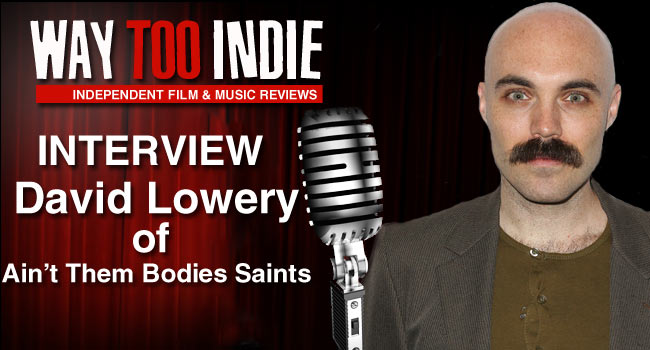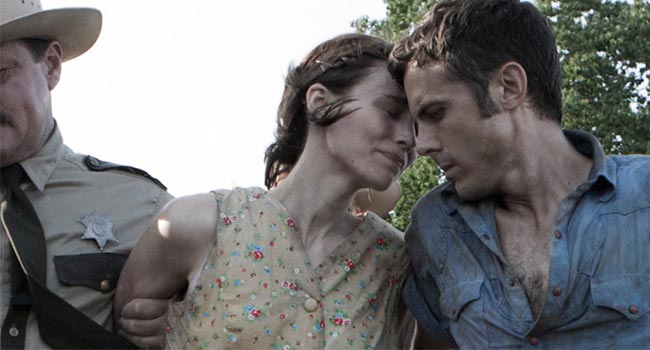Interview: David Lowery of Ain’t Them Bodies Saints

Gaining experience and sharpening his skills as an editor and member of the tight Texas filmmaking community, upstart indie director David Lowery is a student of the game. In his sophomore directorial effort, Ain’t Them Bodies Saints, Casey Affleck stars as an outlaw who, after escaping from prison, is trying to make his way back to the love of his life, Rooney Mara, the Bonnie to his Clyde. Lowery chatted with us about what he likes about American stories, shooting scenes in pitch black, making the film feel “unstuck in time”, Mara and Affleck’s chemistry, and more.
Ain’t Them Bodies Saints opens this Friday
You’ve cited Cormac McCarthy as a big influence on the film, which is an American tale about outlaws. What do you like most about American stories?
As I’ve gotten older and developed a greater appreciation for history, I appreciate [American stories] as someone who lives in this country. When I was in Junior High, I hated history class, but by the time I got to college I really enjoyed it; learning where we came from and how we developed, and seeing a compressed version of the past 100 years over the course of a college class was a fascinating way to get a perspective on where we are and who we are as a culture. I think artists like Cormac McCarthy and, to some extent, Terrence Malick, deal with the history of this country in a really perceptive and sensitive way. As violent as something like “Blood Meridian” might get, it’s also a very sensitive portrayal of how we got to where we are today as a culture.
Did you watch a lot of these kinds of American films in preparation for Saints? What did you want to contribute to the long line of “Great American Tale” movies through your voice?
I watched a lot of Altman films like McCabe & Mrs. Miller, and Thieves Like Us. I watched Nicholas Ray’s version of Thieves Like Us, which is They Live by Night, and I watched his film On Dangerous Ground as well. I looked at a few westerns. You know what? I tried not to watch too many movies because I didn’t want to conscientiously deriving from too much stuff, because the movie is participating in a familiar cinematic tradition. Regardless of whether or not I’m deliberately referencing certain movies, all of the references are going to be there. I definitely try to keep the tradition in mind.
As for what I bring to that tradition, it’s still something I’m trying to figure out. I’ve got my own perspective and my own voice. It’s something that I’m trying to figure out by myself. I try to operate on that level most of the time. I try to think of things on an instinctive level, especially when it comes to the creative process. I trust in myself that I have something valuable to contribute and hoping that it comes out in a precise, erudite, and meaningful fashion. Beyond whatever that voice might be, I really wanted to tell a very familiar story, but focus on aspects of it that I always wanted to know more about. I’ve always been more interested in the aftermath of the action. I wanted to know what happened to those characters in Badlands after the movie ended. The cops who shot Bonnie and Clyde; I wanted to know what happened at dinner that evening. That’s the type of stuff that I’m interested in. It was a very natural place for me to go once I started telling the story and participating in that storytelling tradition, focusing on those elements.
The film feels “unstuck in time”, never really specifying what decade we’re actually in, which gives it an almost mythical feel. What was behind the decision to not strongly indicate when the story takes place, and what do you think it adds to the film?
When we were location scouting for the movie, we’d go to these small towns in Texas, including Meridian, Texas, which is where the movie takes place. It has that “unstuck in time” feel. That’s a phrase I’ve always loved, ever since I read “Slaughterhouse Five”. It’s such a wonderful phrase. There’s something so electric about that idea. So, you go to these towns, and nothing’s really changed since the post-war year when they were built. It’s partially because it’s a rural community and people hang on to things; they drive the same trucks, they wear hand-me-down clothes. Everything is meant to last because they work on farms and they don’t want to buy a new pair of overalls every two weeks. It really has the strange effect of not knowing what time period you’re in when you’re there.
I thought that that would be helpful for the movie in terms of not defining it by a time period. It’s defined by the fact that it takes place in the past, but beyond that, there’s no indication as to whether it’s the ‘70s, the ‘60s, or the ‘50s. You can look at the cars and think, “OK, that’s a 1974 automobile, so this must be the ‘70s.” But Ruth (Rooney Mara’s character) will be wearing something from the ‘40s. It’s a constant blend of eras. I felt that by doing that and not indicating what year the movie took place in would allow it to exist in the past but also have a currency that was very immediate and very truthful.

You never went to film school, correct?
That’s correct.
That’s great, because the film is very, very technical. You pull of some amazing shots, especially some almost incredibly dark ones at night. In production, do you say, “Let’s try to shoot this scene in pitch black—it’ll be a challenge” or do you let the story dictate whether or not you attempt these technical tricks?
It’s usually in service of the story. There are very few examples [in this movie] in which I’d say we were trying to show off. In fact, I’d say if there was an opportunity to show off, we’d go the opposite direction. We didn’t want to do something that was flagrantly over-the-top or technical. Everything was designed to add to the movie, add to the tone, and be consistent in that manner. I felt that, if we were ever showing off or doing something that involved too much trickery, we were forgetting what we were doing. We were getting away from the story we were trying to tell.
At the same time, there’s no denying that you want to make the movie impressive on a technical level. We definitely were seeing how far we could push things, especially with the darkness. We wanted to see how far we could push it, how far we could get the negative into the shadows. We’d still have information there, but it’d be so dark that you’d have to let your eyes adjust to it. That was an exciting thing to do, but it was also something that came about because we were discussing the themes of the story.
This is a story in which the characters have had their heyday. They’ve had their day in the sun, and now the sun is setting. Everything is receding into the shadows. As we were discussing that, it became very clear that we should try to push the darkness in the image as much as possible. You start of on a thematic level, and then it becomes a technical challenge. There’s no denying that there’s a great, satisfying feeling when you get the dailies back and see that it worked out. There’s a great deal of joy in that, but there’s so much thematic relevance. It’s important to remember that that comes first.
There are a lot of great shots in the film. Can you single one out that you can watch again and are super happy with?
You know that shot of the two of them walking down the hill as they’re being arrested? The shot that’s on the poster? That’s one of those shots that you write a certain way, you describe it in the script, and you hope that it’ll come out and have all the weight that you were trying to imbue it with. I was shooting it and thinking, “This is working. This is working. This is going to be the image to carry this movie.” That’s one that I’m completely happy with. There are all sorts of things in the movie where I see the flaws or mistakes or edits that I wish I could make, but that’s one of those moments where it’s perfect. When I watch it now, I can take solace in the fact that that one shot is exactly what I always wanted it to be.
What I was left with when the movie was over was the great chemistry between Casey and Rooney. What’s interesting is that they spend very, very little onscreen time together.
That’s one of those things where, you write the script and you hope that whoever you cast is going to have that chemistry and it would be enough to sustain the whole movie. That image of them walking down the hill; I knew that that was going to be the image to set the stage for the rest of the movie to happen. It was designed to carry a lot of weight in a purely imagistic sense. But, I also hoped that Rooney and Casey would have that chemistry and you would feel the passion between them in the short amount of screen time they have.
The first day that we shot, it was so clear that they had so much chemistry and that they were able to dial into that level of romance and passion that was almost infectious. We were all sort of giddy watching it, because it was like watching two teenagers in love. It’s a wonderful thing to look at. It was so strong in fact that we decided to add an extra scene at the beginning, because I just wanted to see more of these two characters at that stage in their life. The opening scene in the movie was something that we shot later on because I wanted to spend just a little more time with them.
With your next project, are you looking to tell another story in the “Americana” tradition or move on to something different?
It depends on what my next project ends up being. I’m writing a couple of things. One of them definitely fits into the tradition that this movie operates in. It’s fun to kind of continue along that through line. At the same time, I am also writing something that could take place in Japan. A part of it takes place in China. It’s a very un-American story. I ultimately am always going to tell stories that are personal to me and are about me to some degree. I’ll always fall back on that, because that’s the one thing I know to be true (laughs.) Whether or not the next movie has that “Americana” feel to it or feels like a piece of American history, I don’t know. But it’s definitely something I want to explore in the future.
